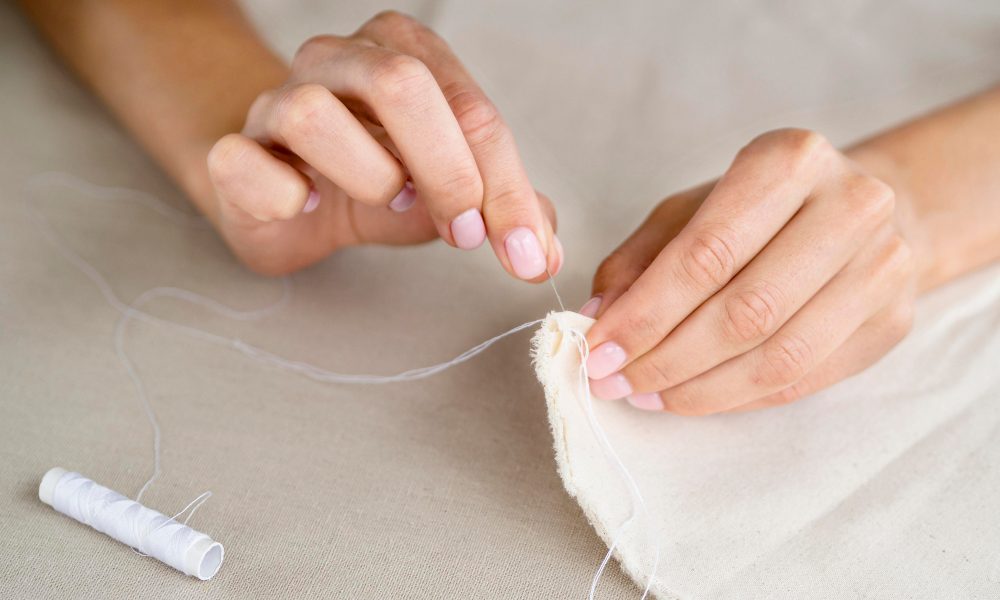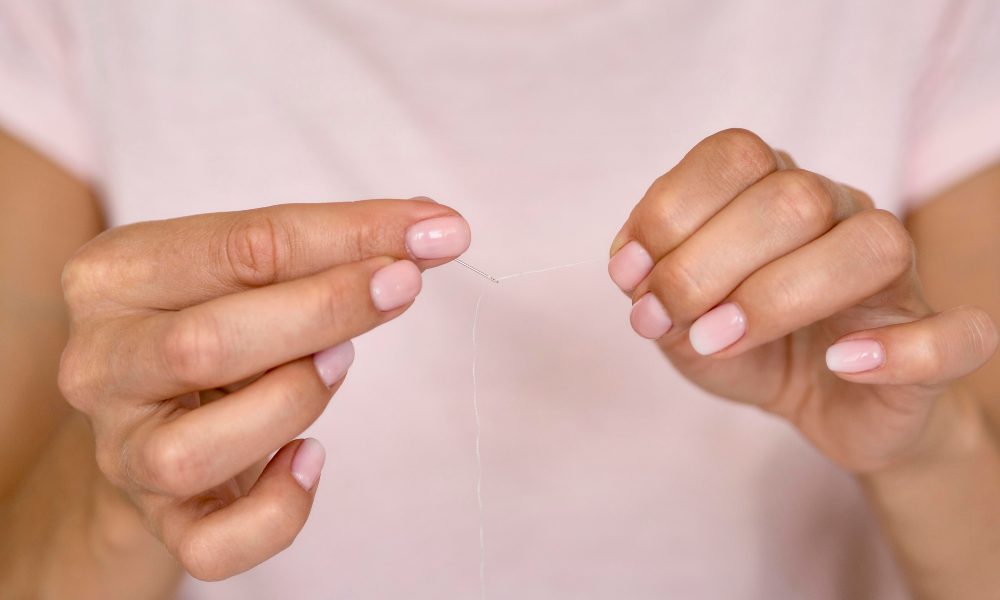Hand sewing, machine sewing, embroidery, knitting, quilting, beading – no matter your preferred craft, working with a tiny needle eye can be frustrating! The eye-opening is scarcely big enough for your thread to squeeze through. You squint and strain, trying to get the tip of the thread inserted just right. Has this scenario led you to exclaim in frustration when trying to thread a needle? Trying large eye needles could make crafting less tedious.
Large needles have a bigger eye-opening and hole to accept thicker threads and yarns readily. This more comprehensive eye minimizes fussing to thread your needle. Using a large eye needle can prevent eye strain and be easier if you have vision challenges, shaky hands, or other motor difficulties. Read on to discover the types and benefits of supersized needles for hand sewing, machine sewing, embroidery, tapestry, quilting, knitting, and beading projects.
Large Eye Sewing Needles Excel at Hand and Machine Sewing
Large eye sewing needles feature an elongated eye compared to standard hand sewing needles. The eye length can range from 1/4 to 1/2 inch long. This extended size enables effortlessly gliding thicker thread, variegated thread, ribbon, yarn, and more through the eye. Large eye needles simplify hand stitching details on doll clothes, cushions, quilts, clothing repairs, and crafts.
John James offers gold-plated large eye needles available individually or in a pack at many online retailers like American Express and Amazon — search sizes 16 through 24, with higher numbers indicating a giant eye and shaft. Gold plating prevents needles from rusting, while Their blue steel construction provides flexibility and durability through projects. Richard Hemming and Sons from the United Kingdom offers nickel-plated large eye-hand needles made sturdy for frequent use. Brands like Colonial, John James, and Richard Hemming receive positive customer reviews for quality large-eye sewing needles.
Opt for large-eye machine needles meant to withstand high sewing speeds for machine sewing. Schmetz brand machine needles are made in Germany and available in sizes 16 through 24. Or try the Organ brand machine needles size 16-26 machine needles feature. Both feature tough chrome plating to resist wear and tear. Large eye machine needles quickly work on projects involving bulky fabrics like denim or leather. Their more comprehensive eye also readily accepts thicker threads like topstitching thread or hand quilting threads. Sew its quilting; customers certainly approve of easier threading and sewing when using large eye machine needles!
Embroidery and Tapestry Crafts Call For Large Eye Crewel/Chenille Needles

Embroiderers will find threading a breeze with oversized eye crewel needles, called chenille or tapestry needles. These sharp, long shafts allow for embroidering fine details with incredibly thick yarns or multiple strands of floss without fabric distortion. A large, elongated eye effortlessly glides wool embroidery threads, pearl cotton, metallics like Medici Wool or Japanese metallic thread, and up to 12 strands of floss through the opening. Brands like John James Gold plated crewel needles minimize yarn shredding and pulling of delicate fabrics like linen, silk, or satin. For cross stitch or needlepoint work, a size 24 chenille needle prevents uneven stitches or thread tension compared to standard sharp embroidery needles.
For tapestry weaving projects like wall hangings or stool covers, try extra large, blunt tapestry needles instead. These large eye-darning needles have rounded tips that protect woven fabrics without catching or tearing threads in the weave. Yet their big opening still fits roving, chunky wool yarns or ribbon. The John James Transparent gold-plated range offers tapestry needles in sizes 16 to 28 to handle any dimensions of yarn or roving. For teaching kids embroidery or weaving, large eye blunt tapestry needles are practically foolproof for preparing woven fabric.
Conquer Knitting and Quilting Fabrics Work with Big Eye Needles
Knitters will love swiftly threading wool yarns, heavy-weight cotton yarns, and novelty thick yarns through the large eyes of knitting needles. Resilient aluminum, wood, or resin knitting needles carved with elongated eyes glide yarn through easily without shredding or excess friction.
For machine quilters, hand quilters, and those sewing quilted fabric projects, look for quilting needles engineered with bigger eyes. Brands like Organ Needles offer chrome-finished machine quilting needles in the standard range of 16 to 26. For hand quilting, John James quilting needles numbered 16-24 have a sharp point and large eye to neatly quilt layers of fabric and batting together. Hand-quilting often involves slowly stitching through layers. Making this process easier on your hands and eyesight with thicker, easier-to-thread quilting needles can help the stitches keep flowing!
Picking the Right Size Big Eye Beading Needle
Delicate seed beadwork and jewelry crafts depend on effortlessly stringing minuscule beads onto a sewing thread or soft beading wire. But trying to thread the slim beading thread through a standard sewing needle is tedious. Large eye-beading needles are made for the job.
With exaggerated elongated eyes, these needles in sizes 12 through 18 can handle a few layers of French beading thread or soft jewelry wire. Sterilized, stainless steel beading needles have thin shafts that have the flexibility to string seed beads or delicas without fraying the thread. Yet their eyes are sizable enough to pass multiple strands of higher weight threads like Power Pro fishing line, Silamide thread, or Czech glass beads with large holes. Always match your beading needle’s eye dimensions, wire gauge, and bead holes before starting jewelry projects or embellishing clothing to prevent snags.
Sources for Finding Quality Large Needles for Hand Work or Machines
While standard machines and hand needles are everywhere, high-quality, large-eye counterparts take some hunting. Check reviews before purchasing large needles in multi-packs from Amazon, Walmart, American Express online shops, Joann Fabrics, and other big chains. Better yet, try shopping at specialty online sewing shops like Connecting Threads, RichardHemming Needlecraft, or extraordinary large eye needle selections at JohnJamesUK.
Your other best bet is visiting local sewing, knitting, embroidery, or craft stores for hands-on help choosing what size large needles suit you best. Explain your project vision to shop staff. Ask experienced sales clerks advice about the optimal needle sizes for the thread weights, fabrics and your abilities. Sometimes test, test-driving needle types will give you the confidence to complete essential projects successfully.
FAQs
What are the benefits of large needles?
Large needles have bigger eye openings that make threading easier. They can handle thicker threads and materials. Large needles are great for people with vision issues or shaky hands.
What kinds of crafts use large needles?
Sewing, embroidery, tapestry weaving, knitting, quilting, and beading projects can all utilize large needles.
What size large needle do I need?
Choose larger numbered needles like 16-24 for bigger eyes. Match the eye size to your thread thickness or yarn weight for best results.
Where can I buy quality large needles?
Specialty online sewing and craft stores offer the best selection. Or visit local sewing, knitting, or bead shops for hands-on advice about sizing.
So next time tiny needle eyes slow down your sewing, embroidery, weaving, knitting, or beading progress, try upgrading to specialized large eye needles. Let us know if sizing up your needles helps your handicraft passion stay enjoyable! Will oversized eyes help your next project feel more accessible to complete?
***
Main image: freepik

